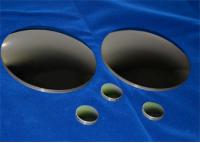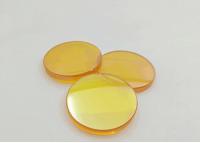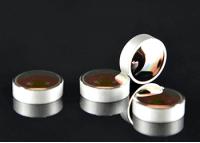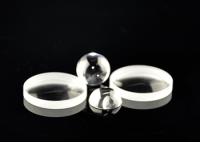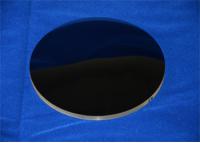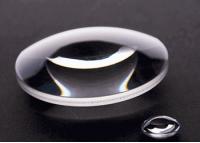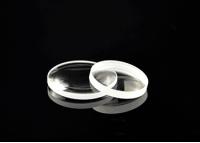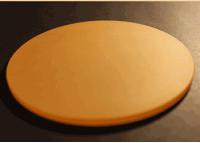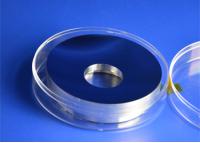Infrared Lenses (Optics)
-
Germanium lenses (Ge lenses) is commonly used in IR imaging systems typically operating in the 2 µm to 16 µm spectral range, covers the LWIR (8-12μm) and MWIR (3-5μm) thermal imaging wavelength range. Germanium has the highest refractive index of commonly available IR-transmitters and has low optical dispersion. This makes it desirable in aspects of lens design where its refractive index allows otherwise impossible specifications to be built. Germanium can be AR coated with Diamond producing an extremely tough front optic, and it is often used as the front optics in lens group. Germanium is more rugged than other IR materials, but caution should be taken for high temperature applications where the material will become opaque in the IR realm as the temperature rises. Beside the general spherical surface lenses, Hangzhou Shalom EO also provide the aspherical surface lenses made by SPDT (Single Point Diamond Turning) technique.
-
Zinc Selenide (ZnSe) lenses is an excellent choice for any IR applications due to its broad wavelength range (3 µm to 16 µm). Zinc selienide is a chemically vapor diposited (or CVD) material commonly used in thermal imaging, CO2 lasers, military and medical systems. Zinc selenide (ZnSe) has a high index of refraction which normally requires an anti-reflection coating to achieve high transmission. Zinc selenide is relatively soft with low scratch resistance thus not recommended for use in harsh enviornment. Extra caution is required during cleaning, handling, and mounting.
-
Chalcogenide glass components are becoming popular in various IR applications due to its excellent wide band transmittance (3-5µm, 8-12µm) with reliable machinability, which perform rather differently from oxides; particularly low band gaps help optical designers to introduce more flexible IR solutions. Hangzhou Shalom EO offers the customized lenses and balls made from chalcogenide, spherical and aspherical lenses by SPDT techniques (Single Point Diamond Turning)are available upon request.
-
Chemically, sapphire is single crystal aluminum oxide (Al2O3) and is useful in a transmission range from 0.2 - 5.5μm, it is suitable for MWIR 3-5μmthermal imaging applications. Sapphire lenses are made from single crystal sapphire, they are ideal for demanding applications because of their extreme surface hardness, high thermal conductivity, high dielectric constant and resistance to common chemical acids and alkalis. Sapphire is the second hardest crystal next to diamonds and, because of their structural strength, sapphire windows can be made much thinner than other common dielectric windows with improved transmittance. Hangzhou Shalom EO provide the customized lenses and balls upon customer's request.
-
Silicon (Si) lenses manufactured from optical grade silicon are popular for the 1.2 - 7μm spectral region due to their low cost and low density. Due to its low density (half that of germanium or zinc selenide), silicon is ideal for weight sensitive applications, especially those in the MWIR thermal imaging 3 - 5μm region. Density is 2.329 g/cm3 and Knoop Hardness is 1150, making it harder and less brittle than germanium.
-
Barium Fluoride can be used in the ultraviolet, visible and infrared spectral regions. Barium Fluoride has transmission above 90% between 0.25 and 9.5µm. Barium Fluoride is half as hard as Calcium Fluoride and also more susceptible to thermal shock. However, it is commonly used in cryogenically cooled thermal imaging systems. It is somewhat more expensive than Calcium Fluoride and not as readily available in large sizes. Hangzhou Shalom EO offer the BaF2 lenses used in MWIR (3-5 micro) thermal imaging applications.
-
Due to its high average transmission and low chromatic aberration relative to other IR materials, calcium fluoride(CaF2 ) is an excellent choice for windows and lenses for spectroscopy applications in the deep UV to near IR wavelength range (180 nm-8 µm). For its good transmission properties at LWIR range, the CaF2 are often selected as the lenses for MWIR (3-5 micro)thermal imaging applications.
-
ZnS or Zinc Sulphide crystals grown by chemical vapor desposition (or CVD) exhibits exceptional fracture strength and hardness leading to its frequent choice for military applications or other harsh environments. This material is often used in the LWIR 7 to 14 microns region of thermal imaging. Its high resistance to rain erosion and high-speed dust and particulate abrasion makes it particularly suitable for exterior IR windows on aircraft frames.
Hangzhou Shalom EO provides the ZnS lenses of IR grade and Cleartran or multi-spectrum grade materials, the AR/AR coating is made to increase the transmission of the lenses.
-
Al(Aluminum) refraction lenses is commonly used in thermal imaging systems, covers long focal length lenses for the MWIR, LWIR applications.
For example, continuous zoom lenses and double FOV with long focal length lenses.



